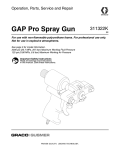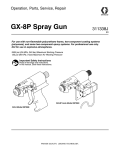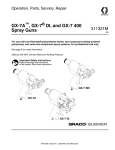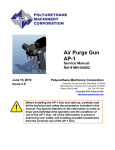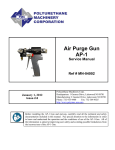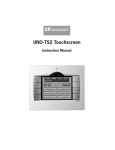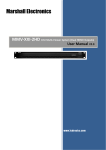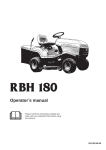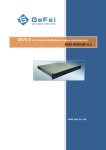Download Graco Inc. 295530 Paint Sprayer User Manual
Transcript
Operation, Parts, Service and Repair Model D Spray Gun 311320G ENG For use with non-flammable polyurethane foams. For professional use only. Not for use in explosive atmospheres. See page 2 for model information. 1000 psi (7 MPa, 70 bar) Maximum Working Pressure Important Safety Instructions Read all warnings and instructions in this manual. Save these instructions. Models Contents Models . . . . . . . . . . . . . . . . . . . . . . . . . . . . . . . . . . . 2 Warnings . . . . . . . . . . . . . . . . . . . . . . . . . . . . . . . . . 3 Overall View . . . . . . . . . . . . . . . . . . . . . . . . . . . . . . . 5 Major Components . . . . . . . . . . . . . . . . . . . . . . . 5 Centerline Components . . . . . . . . . . . . . . . . . . . 6 Operation Basics . . . . . . . . . . . . . . . . . . . . . . . . . . . 7 Isocyanate Hazard . . . . . . . . . . . . . . . . . . . . . . . 7 Keep A and B Components Separate . . . . . . . . . 7 Grounding . . . . . . . . . . . . . . . . . . . . . . . . . . . . . . 7 Coupling Block . . . . . . . . . . . . . . . . . . . . . . . . . . 7 Air Hose Connection . . . . . . . . . . . . . . . . . . . . . . 9 Valving Rod Adjustment Screw . . . . . . . . . . . . . . 9 Air Cap Adjustment Valve . . . . . . . . . . . . . . . . . 10 Felt Wiper . . . . . . . . . . . . . . . . . . . . . . . . . . . . . 10 Initial Set Up . . . . . . . . . . . . . . . . . . . . . . . . . . . . . . 11 Daily Start-Up . . . . . . . . . . . . . . . . . . . . . . . . . . . . . 12 Daily Shutdown . . . . . . . . . . . . . . . . . . . . . . . . . . . 12 Pressure Relief Procedure . . . . . . . . . . . . . . . . . . 13 Spray Pattern Adjustment . . . . . . . . . . . . . . . . . . . 14 Maintenance . . . . . . . . . . . . . . . . . . . . . . . . . . . . . . 17 Gun Service Kits . . . . . . . . . . . . . . . . . . . . . . . . 17 Clean Spray Gun Procedure . . . . . . . . . . . . . . . 18 Repair . . . . . . . . . . . . . . . . . . . . . . . . . . . . . . . . . . . 19 Filter Screen Removal and Service . . . . . . . . . . 19 Clean Injection Slots . . . . . . . . . . . . . . . . . . . . . 20 Valving Rod Adjustment . . . . . . . . . . . . . . . . . . 21 Centerline Component Removal . . . . . . . . . . . . 22 Centerline Component Installation . . . . . . . . . . 24 Parts . . . . . . . . . . . . . . . . . . . . . . . . . . . . . . . . . . . . 26 Model D Spray Gun Assembly . . . . . . . . . . . . . . 26 Air Cylinder Assembly . . . . . . . . . . . . . . . . . . . . 30 Coupling Block Assembly . . . . . . . . . . . . . . . . . 31 Notes . . . . . . . . . . . . . . . . . . . . . . . . . . . . . . . . . . . . 32 Technical Data . . . . . . . . . . . . . . . . . . . . . . . . . . . . 33 Graco Standard Warranty . . . . . . . . . . . . . . . . . . . 34 Graco Information . . . . . . . . . . . . . . . . . . . . . . . . . 34 Models 2 Part No. Description Mix Module 295530 295531 295532 295533 D-55 D-55-RECIRC D-62 D-70 296597 296597 296598 296599 311320G Warnings Warnings The following general warnings are for the setup, use, grounding, maintenance, and repair of this equipment. Additional, more specific warnings may be found throughout the body of this manual where applicable. Symbols appearing in the body of the manual refer to these general warnings. When these symbols appear throughout the manual, refer back to these pages for a description of the specific hazard. WARNING PERSONAL PROTECTIVE EQUIPMENT You must wear appropriate protective equipment when operating, servicing, or when in the operating area of the equipment to help protect you from serious injury, including eye injury, inhalation of toxic fumes, burns, and hearing loss. This equipment includes but is not limited to: • Protective eyewear • Clothing and respirator as recommended by the fluid and solvent manufacturer • Gloves • Hearing protection TOXIC FLUID OR FUMES HAZARD Toxic fluids or fumes can cause serious injury or death if splashed in the eyes or on skin, inhaled, or swallowed. • Read MSDS’s to know the specific hazards of the fluids you are using. • Store hazardous fluid in approved containers, and dispose of it according to applicable guidelines. SKIN INJECTION HAZARD High-pressure fluid from gun, hose leaks, or ruptured components will pierce skin. This may look like just a cut, but it is a serious injury that can result in amputation. Get immediate surgical treatment. • Do not point gun at anyone or at any part of the body. • Do not put your hand over the spray tip. • Do not stop or deflect leaks with your hand, body, glove, or rag. • Do not spray without tip guard and trigger guard installed. • Follow Pressure Relief Procedure in this manual, when you stop spraying and before cleaning, checking, or servicing equipment. 311320G 3 Warnings WARNING FIRE AND EXPLOSION HAZARD Flammable fumes, such as solvent and paint fumes, in work area can ignite or explode. To help prevent fire and explosion: • Use equipment only in well ventilated area. • Eliminate all ignition sources; such as pilot lights, cigarettes, portable electric lamps, and plastic drop cloths (potential static arc). • Keep work area free of debris, including solvent, rags and gasoline. • Do not plug or unplug power cords, or turn power or light switches on or off when flammable fumes are present. • Ground all equipment in the work area. See Grounding instructions. • Use only grounded hoses. • Hold gun firmly to side of grounded pail when triggering into pail. • If there is static sparking or you feel a shock, stop operation immediately. Do not use equipment until you identify and correct the problem. • Keep a fire extinguisher in the work area. EQUIPMENT MISUSE HAZARD Misuse can cause death or serious injury. • Do not operate the unit when fatigued or under the influence of drugs or alcohol. • Do not exceed the maximum working pressure or temperature rating of the lowest rated system component. See Technical Data in all equipment manuals. • Use fluids and solvents that are compatible with equipment wetted parts. See Technical Data in all equipment manuals. Read fluid and solvent manufacturer’s warnings. For complete information about your material, request MSDS forms from distributor or retailer. • Check equipment daily. Repair or replace worn or damaged parts immediately with genuine Graco/Gusmer replacement parts only. • Do not alter or modify equipment. • Use equipment only for its intended purpose. Call your Graco/Gusmer distributor for information. • Route hoses and cables away from traffic areas, sharp edges, moving parts, and hot surfaces. • Do not kink or over bend hoses or use hoses to pull equipment. • Keep children and animals away from work area. • Comply with all applicable safety regulations. PRESSURIZED EQUIPMENT HAZARD Fluid from the gun/dispense valve, leaks, or ruptured components can splash in the eyes or on skin and cause serious injury. • Follow Pressure Relief Procedure in this manual, when you stop spraying and before cleaning, checking, or servicing equipment. • Tighten all fluid connections before operating the equipment. • Check hoses, tubes, and couplings daily. Replace worn or damaged parts immediately. 4 311320G Overall View Overall View Major Components Spring Retainer Case Valving Rod Closure Spring Valving Rod Positioner Valving Rod Adjustment Screw Valving Rod Stop Bar Valving Rod Gun Block Piston Rod Trigger Air Cap Adjustment Valve Coupling Block Coupling Block Mounting Screw FIG. 1: Major Components 311320G 5 Overall View Centerline Components Gun Block Mounting Screw Screen Screw O-Ring Closure Screw Valving Rod Assembly A-Iso Check Valve Seal Felt Wiper Retainer Gun Block R-Resin Check Valve Screen Mounting Screw Screen Snap Ring Mixing Chamber Case Air Cap Coupling Block Gaskets FIG. 2: Centerline Components 6 311320G Operation Basics Operation Basics To prevent accidental gun operation, always disconnect air supply before servicing gun or anytime gun is not in use. Isocyanate Hazard Spraying materials containing isocyanates creates potentially harmful mists, vapors, and atomized particulates. Read material manufacturer’s warnings and material MSDS to know specific hazards and precautions related to isocyanates. Prevent inhalation of isocyanate mists, vapors, and atomized particulates by providing sufficient ventilation in the work area. If sufficient ventilation is not available, a supplied-air respirator is required for everyone in the work area. To prevent contact with isocyanates, appropriate personal protective equipment, including chemically impermeable gloves, boots, aprons, and goggles, is also required for everyone in the work area. Grounding Check your local electrical code and proportioner manual for detailed grounding instructions. Ground the spray guy through connection to a Graco-approved grounded fluid supply hose. Coupling Block Install Coupling Block 1. Inspect coupling block gaskets for damage and wear. Replace if necessary. 2. With gaskets in place, fit coupling block to gun block. 3. Insert coupling block mounting screw and tighten securely with 5/16 in. nut driver. Coupling Block Gaskets Keep A and B Components Separate CAUTION To prevent cross-contamination of the gun’s wetted parts, do not interchange A component (isocyanate) and B component (resin) parts. The gun is shipped with the A side on the left. 311320G Coupling Block Mounting Screw FIG. 3: Coupling Block 7 Operation Basics Manual Valves Triggering gun with manual valves closed may cause crossover if gun ports contain residual chemical. Never open manual valves unless coupling block is secured to gun or exit port is directed into flush pail. 1. Open manual valves using 5/16 in. nut driver; turn manual valves counterclockwise approximately three full turns. Do not open until it bottoms out. 2. Close manual valves by turning fully clockwise. Remove Coupling Block To prevent release of pressurized chemical, close both manual valves before removing coupling block. 1. Disconnect air hose. 2. Close both manual valves. 3. Remove coupling block mounting screw (FIG. 3). 4. Separate coupling block from gun. Do not lose gaskets. 5. Use gun cleaner to wipe clean mating surface of gun block and coupling block. Cover exposed opening with grease. Manual Valves FIG. 4: Manual Valves 8 311320G Operation Basics Air Hose Connection To CONNECT air hoses, pull back sleeve of female fitting, insert male fitting and slide sleeve forward to secure connection. To DISCONNECT air hoses, pull back sleeve of female fitting and remove male fitting. Pull Sleeve Valving Rod Adjustment Screw Use to regulate amount of valving rod travel when gun trigger is depressed with air supply connected. Turn clockwise to decrease travel, and counterclockwise to increase travel. 1. Use 5/64 in. hex key wrench to loosen friction lock. 2. Turn adjustment screw as required and tighten friction lock until screw no longer easily turns by hand. 3. Check friction lock periodically and tighten as required to prevent screw from slipping during operation. Friction Lock FIG. 5: Air Hose Connection FIG. 6: Valving Rod Adjustment Screw 311320G 9 Operation Basics Air Cap Adjustment Valve 3. Use 5/16 in. open-end wrench to tighten retainer another half turn. Use to control amount of air that passes through air cap and over mixing chamber tip. Airflow helps keep tip free of sprayed chemical. Too much air may distort spray pattern and create overspread. Too little air will not properly clean end of valving rod. To OPEN valve, turn knob approximately 1/8 turn counterclockwise. To CLOSE valve, turn knob fully clockwise. FIG. 8: Felt Wiper Clean Felt Wiper 1. Insert nozzle of flush can into holes of felt wiper. Open 2. Saturate felt with gun cleaner. Close FIG. 7: Air Valve Adjustment Felt Wiper Adjust Felt Wiper 1. Use 5/16 in. open-end wrench to loosen retainer slightly. 2. Slowly tighten it by hand until it seats against rear packings in mixing chamber. 10 311320G Initial Set Up Initial Set Up 1. Remove coupling block from gun. 2. Check valving rod clearance in closed position. Rod should extend approximately 1/32 in. (1 mm) beyond tip of mixing chamber. If it does not, see Valving Rod Adjustment procedure, page 21. 1/32 in. FIG. 9: Valving Rod (Closed Position) b. Open each manual valve to allow trapped air to escape. Bleed each side until chemical is free of air. c. Close both manual valves. 9. Use clean cloth soaked in gun cleaner to wipe clean coupling block and its mating surfaces. CAUTION To avoid accumulation of dirt and other contaminants, do not apply grease to mating surfaces of coupling block. 3. Adjust valving rod travel to initial setting. 10. Install coupling block to gun block. a. Loosen friction lock. Turn valving rod adjustment screw clockwise until it stops. 11. Proceed with Daily Start-up procedure or Shutdown procedure as required. b. Turn valving rod adjustment screw 11 turns counterclockwise. 4. Connect air supply hose to gun. 5. Connect A-isocyanate hose (red-taped) to notched fitting on coupling block. Then connect R-resin hose (blue-taped) to fitting without notches on coupling block. 6. Close both manual valves. 7. Pressurize the A and R chemical hoses and check for leaks. (See Proportioning Unit manual.) 8. Bleed air from chemical hoses: a. Hold coupling block with exit ports pointed into disposable container. 311320G 11 Daily Start-Up Daily Start-Up Ensure gun is attached to coupling block and air hose, and the proportioning unit is at desired temperature and pressure. 1. Connect air supply to gun, page 9. 2. Adjust air cap valve, page 10. 3. Saturate felt in felt wiper with gun cleaner using flush can. 4. Trigger gun multiple times to ensure valving rod moves the full travel quickly and freely. Daily Shutdown Follow when gun is out of service for any length of time. Daily disassembly of gun for cleaning is not recommended if it has been operating properly. However, if you remove the gun from the coupling block, flush and clean thoroughly. 1. Follow Pressure Relief Procedure, page 13. 2. Shut down proportioning unit as required. CAUTION Sluggish valving rod action may result in valving rod sticking in open position when fluid pressure is applied. Always have a 5/16 in. nut driver available to quickly close manual valves on coupling block. 5. Open both manual valves, page 8. 6. Test spray on disposable surface and adjust spray pattern as needed. (See Spray Pattern Adjustment procedure, page 14.) Do not exceed 1000 psi (7 MPa, 70 bar) maximum fluid working pressure even in static de-triggered conditions, or check valve damage may result. 12 311320G Pressure Relief Procedure Pressure Relief Procedure Relieve pressure before cleaning or repairing gun. 1. Close both manual valves. Manual Valves 2. Trigger gun once onto waste area to relieve fluid pressure in front end of gun. 3. Disconnect gun air supply, page 9. 4. If gun is removed from coupling block, follow Clean Spray Gun Procedure, page 18. If fluid in hose and proportioner is still under pressure, follow Pressure Relief Procedure in proportioner manual To relieve pressure in hose after gun is removed, place fluid manifold over containers, facing away from you. Very carefully open fluid valves. Under high pressure, fluid will spray sideways from fluid ports. 311320G 13 Spray Pattern Adjustment Spray Pattern Adjustment This adjustment may create a large mass “bun” of urethane foam. Very high temperatures created by chemical reaction inside a bun may not dissipate after outside surface has cooled. A large bun may continue to react for several hours after spraying until flash (burning) point of foam is reached. ALWAYS break buns into smaller pieces so heat can escape. 1. Check valving rod clearance in closed position. Rod should extend approximately 1/32 in. (1 mm) beyond tip of mixing chamber. If it does not, see Valving Rod Adjustment procedure, page 21. from retainer case by 1/4-turn increments in counterclockwise direction. c. Point of valving is reached when chemical stream mists as shown in FIG. 11. 1/32 in. FIG. 10: Valving Rod (Closed Position) 2. Adjust valving rod travel to initial setting. a. Loosen friction lock. Turn valving rod adjustment screw clockwise until it stops. b. Turn valving rod adjustment screw 11 times counterclockwise. 3. Locate point of valving: a. Aim gun at disposable target. b. Dispense short (1 second) bursts toward target while simultaneously withdrawing valving rod adjustment screw 14 FIG. 11: Point of Valving 4. Adjust spray pattern. Note position of notch in hexhead of adjustment screw, then back screw out counterclockwise the number of turns specified in Table 1. Notice spray pat- 311320G Spray Pattern Adjustment tern opens as adjustment is made (FIG. 12). FIG. 14: Split Pattern FIG. 12: Opening Spray Pattern 5. Fine tune spray pattern: a. After you back out adjustment screw, make fine adjustments (1/8 turns or less in either direction as required) to obtain pattern shown in FIG. 13. Moving the screw out beyond this point may cause the pattern to split, as shown in FIG. 14. FIG. 13: Desired Pattern 311320G b. If full-round pattern cannot be achieved, ensure that material temperature and spray pressure are correct. If pattern remains closed upon reaching maximum specified number of turns out from point of valving, material temperature is too low c. If pattern splits or has hollow center, even with the adjustment screw at minimum number of turns from point of valving, material temperature is too high. Refer to FIG. 12. d. After reaching satisfactory spray pattern, note temperatures at proportioner and hose, and position of notch on the adjustment screw. As spraying proceeds, pattern may occasionally streak or change. If this happens, inspect chamber tip and remove any build-up of solid foam with wooden stick or brass wire brush. 15 Spray Pattern Adjustment e. If buildup recurs shortly after cleaning tip, remove air cap and ensure inside is clean. Reinstall air cap and ensure airflow is properly set. If no buildup occurred on air cap, check the following items in this order and readjust if necessary: • Check Valving Rod Adjustment Screw/Sleeve setting. Turns Out From Point of Valving Chamber Minimum Maximum 46-800 46-810 55-776 1/2 turn 1/2 turn 1 3/4 turns 2 turns 2 turns 2 5/8 turns 62 2 turns 3 turns 70 2 turns 3 turns 78-851 2 turns 3 turns • Check hose temperature setting. • Check primary heater temperature setting. • Ensure spray pressures between chemicals are balanced. If they are not, refer to Troubleshooting section of Proportioning Unit Operation Manual for the proportioner in use. • Ensure flow of air to air cap is adequate but not excessive. Recommended Distance of Gun from Surface Pattern Size 12 in. (304-8 mm) 12 in. (304-8 mm) 18 to 20 in. (457.2 to 508 mm) 18 to 20 in. (457.2 to 508 mm) 18 to 20 in. (457.2 to 508 mm) 24 in. (609.6 mm) 6 in. (152.4 mm) 6 in. (152.4 mm) 8 in. (203.2 to 228.6 mm) 8 to 9 in. (203.2 to 228.6 mm) 10 to 12 in. (254 to 304.8 mm) 14 in. (355.6 mm) Table 1: Valving Rod Adjustment for Standard Mixing Chambers 16 311320G Maintenance Maintenance Gun Service Kits Use either the 1-Quart Gun Service Kit (296980) or 3-Gallon Gun Service Kit (296981) to perform daily flushing of spray gun without disassembly. FIG. 16: 3-Gallon Gun Service Kit For more information about the 3-Gallon Gun Service Kit, see manual 311341. FIG. 15: 1-Quart Gun Service Kit For more information about the 1-Quart Gun Service Kit, see manual 311340. 311320G 17 Maintenance Clean Spray Gun Procedure Thoroughly flush gun block with gun cleaner before removing valving rod or mixing components from gun block. Also allow chemicals in spray gun to cool before cleaning. 12. Clean screens, check valves and screen screw. See Filter Screw Removal and Service procedure, page 19. Inspect air cap, mixing chamber, and gun block for build up of material and clean as required. Do not use metal cleaning devices to clean plastic components. This procedure makes use of the 1-Quart or 3-Gallon Gun Service Kit. 1. Close both manual valves. 2. Remove gun from coupling block. 3. Attach service block of gun service kit to spray gun, and then tighten using 5/16 in. nut driver. 4. Pressurize container to 100 psi. 5. Open one manual valve on service block. 6. Trigger gun while holding against a grounded waste container until there is a fine, unobstructed mist of gun cleaner. 7. Release trigger of gun and 1-quart kit, and close manual valves on service block. 8. Repeat steps 5-7 for other side of gun. 9. After initial cleaning, remove air cap and flush a second time to ensure thorough cleaning. 10. Remove service block of gun service kit from spray gun. 11. Disconnect air supply. 18 311320G Repair Repair Shut down proportioner and allow chemicals to cool before performing any repair procedures. Clean Center Line Components using Gun Service Kit prior to performing any repair procedures. Filter Screen Removal and Service 1. Perform Pressure Relief Procedure (page 13) and Clean Spray Gun Procedure, page 18. 2. Unthread screen mounting screw. Remove screen mounting screw and filter screen assembly from gun block. Screen Screw 4. Clean and inspect screen cavity. If particles are visible, remove with cleanout drills and flush thoroughly with gun cleaner. CAUTION Any remaining material in cavity on down stream side of screen will clog mixing chamber. 5. Inspect seal, and replace if worn or damaged. 6. Reinstall filter screen assembly. With seal in place, install screen and retainer clip-on screen screw. Seal Screen Snap Ring 7. Install screen assembly to gun block. Ensure screw is tight to prevent leakage. 8. Flush gun after cleaning cavity and screen. See Clean Spray Gun Procedure, page 18. Mounting Screw FIG. 17: Filter Screen Assembly 3. Remove screen screw retainer (snap ring at end of screw) and screen. If screen is dirty and clogged, replace it. 311320G 19 Repair Clean Injection Slots 1. Perform Pressure Relief Procedure (page 13) and Clean Spray Gun Procedure, page 18. 7. Flush injection slots. With valving rod in open position, flush each injection slot with gun cleaner. Press flush can needle firmly into cleanout hole to create seal. Continue until gun cleaner sprays out chamber tip. 2. Remove check valves. 8. Inspect and clean check valves, page 22. A-Iso Check Valve (tall hexhead) 9. Install tall hexhead check valve on Isocyanate side, and short hexhead on Resin side. 10. Adjust valving rod adjustment screw one turn clockwise. Clean-out Port (both sides) R-Resin Check Valve (short hexhead) FIG. 18: Check Valves 3. Inspect check valves to ensure sleeve is secured, and place check valves in separate containers of gun cleaner. 4. Flush cleanout ports with gun cleaner. 5. Turn valving rod adjustment screw one full turn counterclockwise to ensure valving rod will be withdrawn completely past injection slot. 6. Clean mixing chamber injection slots. With air supply connected to gun, depress and hold trigger to keep valving rod in open position. Insert appropriate cleanout spade into cleanout hole and mixing chamber. CAUTION To prevent damage to chamber, do not release trigger while cleanout spade is in chamber slot. 20 311320G Repair Valving Rod Adjustment In closed position, valving rod should extend approximately 1/32 in. (1 mm) beyond tip of mixing chamber. If it does not, follow this procedure: 5. Remove valving rod. Push back firmly on piston rod until end of Stop Bar emerges from cylinder. Positioner 1/32 in. FIG. 19: Valving Rod (Closed Position) 1. Perform Pressure Relief Procedure (page 13) and Clean Spray Gun Procedure, page 18. 2. Disconnect air supply from gun. 3. Remove spring retainer case. Firmly grasp spring retainer case, push in and rotate counterclockwise. Pull spring out of air cylinder. Stop Bar FIG. 21: Valving Rod Removal 6. Loosen stop bar from positioner. Turn positioner to adjust length of valving rod as required. Retighten stop bar against positioner. 7. Replace valving rod, spring, and spring retainer case. Grasp firmly, push in, and turn clockwise to lock in place. Spring Retainer Case 8. Adjust felt wiper and soak with gun cleaner. 9. Connect air supply to gun. Spring FIG. 20: Retainer Case Removal 10. Check action of valving rod. With manual valves closed, press trigger several times and ensure valving rod moves freely. If you have encountered no problems, spray gun is ready for test spray. Follow Daily Start-up procedure (page 12) and Spray Pattern Adjustment procedure (page 14). 4. Loosen felt wiper retainer 2-3 turns (DO NOT REMOVE). 311320G 21 Repair Centerline Component Removal tool into rear of gun block and tap with hammer until chamber ejects. Place chamber in gun cleaner. Mixing Chamber Refer to Figure 2 to view centerline components. 1. Perform Pressure Relief Procedure (page 13) and Clean Spray Gun Procedure, page 18. 2. Remove air cap by hand, turning it counterclockwise. Chamber Knockout Tool FIG. 22: Mixing Chamber Removal 3. Remove screen screw assembly. Flush and place in gun cleaner. 4. Remove check valves. Flush and place in gun cleaner. 5. Flush screen screw and check valve ports. 6. Remove spring retainer case by firmly grasping knob of case. Push in and rotate counterclockwise to remove from air cylinder. Pull spring out of air cylinder. 7. Loosen felt wiper retainer 2-3 turns. DO NOT REMOVE. 8. Remove valving rod. Push back firmly on piston rod until end of valving rod stop bar emerges from cylinder. CAUTION Matching tapers on mixing chamber and center hole in gun block are machined to an exact fit to hold chambers in place and create a leak-proof seal. When handling or cleaning these parts be careful not to damage finish. Do not use metal tools to clean these parts. 12. Remove closure screw in top of gun block. Place screw in gun cleaner and clean entire gun using appropriate cleanout tools and brass brushes. Then flush thoroughly with gun cleaner. 13. Disassemble check valve assemblies. 9. Remove gun block from frame. Screw 10. Unscrew felt wiper assembly from rear of mixing chamber. Keep rear of mixing chamber in upright position to prevent possible loss of internal chamber parts. Ensure brass retaining sleeve is not stuck to felt wiper. Place wiper assembly in gun cleaner. 11. Remove mixing chamber. Hold gun block in one hand with chamber tip pointing into your palm. Insert mixing chamber knockout 22 Sleeve Ball and Spring FIG. 23: Check Valves 311320G Repair a. Remove ball and spring assembly. Hold ball and unscrew assembly. If dirt or material build-up prevents complete removal of the spring, screw it back in. Soak assembly in gun cleaner and try to remove it again. If ball and spring assembly cannot be removed undamaged, replace it. b. Use check valve cleanout drill to clean inside of closure screw. Insert the flattened end of cleanout drill into opening at end of screw, avoiding spurs in the closure screw. Do not spin drill until the flat on the drill has cleared spurs. Spin drill with your fingers to loosen any buildup, then remove drill and flush inside of screw with gun cleaner. Next, check area where ball seats for damage. Also check sleeve for damage; it should fit tightly on the end of the screw. If there is damage or if the sleeve fits loosely, replace it. Replace sleeve if check valve can be threaded all the way into gun block by hand. A good check valve requires the use of a 5/16 in. nut driver to make the last 1/4 turn, compressing the sleeve. This compression is required to create an internal seal in the gun block. c. Remove damaged check valve sleeve. Remove ball and spring. Insert check valve into check valve sleeve removal block (FIG. 24). While holding block, and keeping pressure on head of check valve, slice check valve sleeve with razor knife at a 10 - 15 degree angle relative to the plane of removal block. Remove check valve from block and peel sleeve off. If check valve sleeve remains in gun block after removing 311320G check valve, use extractor tool to remove sleeve. Insert threaded end of tool into cleanout port and, while pressing tool into gun block, turn it clockwise several times. Withdraw tool from gun block; sleeve should slide out with tool. Check Valve Sleeve Insert Check Valve FIG. 24: Sleeve Removal Block d. Insert spring assembly into check valve and turn the screw clockwise. When the spring is fully inserted, stem will jump over spurs in screw and make clicking sound. Ensure ball fully seats in check valve. If not, or ball is damaged, replace with new ball and spring assembly. 14. Remove retaining ring, washer, and felt wiper from retainer. Flush retainer with gun cleaner, insert new felt wiper and washer, then install retaining ring. Loosely thread felt wiper retainer into rear of mixing chamber (DO NOT TIGHTEN). If not installing to gun block, store assembly in plastic vial with corresponding cleanout spade. 23 Repair Centerline Component Installation All gun block parts must be clean and free of damage before installation. 1. Remove felt wiper assembly from rear of mixing chamber. 2. Ensure internal mixing chamber parts are in place. 3. Insert chamber into gun block. Align keyway in chamber with pin protruding from top of hole in block. 5. Thread felt wiper assembly into back of mixing chamber. Do not tighten. CAUTION Failure to install felt wiper in rear of chamber allows internal chamber parts to fall out when chamber is tapped into place. 6. With rear of gun block facing palm of your hand, place mixing chamber insertion block over nose of chamber so it rests squarely on the chamber flange. Firmly tap insertion block with hammer until flange of chamber is flush with face of gun block (FIG. 27). Chamber Insertion Block FIG. 27: Chamber Seating FIG. 25: Mixing Chamber Insertion 4. Press chamber into block so that flange is 1/32 - 1/16 in. above face of gun block. 1/32 in. 1/16 in. FIG. 26: Chamber Positioning 24 7. With o-ring in place on underside of gun frame, assemble block to frame. 8. Install valving rod assembly. If using new felt wiper, push valving rod through felt with retainer case off chamber. Remove felt wiper and any felt buildup on tip of rod. Install wiper, hand tighten into rear of chamber in gun block. Then insert valving rod through piston in air cylinder, guiding it through center of felt wiper retainer. Use firm pressure to carefully push valving rod into mixing chamber until piston of air cylinder bottoms out. 9. Check valving rod clearance. If it does not extend approximately 1/32 in. (1mm) beyond tip of mixing chamber, see Valving Rod Adjustment, page 21. 311320G Repair 10. Replace valving rod spring and spring retainer case. Grasp knob, push in, and turn clockwise to lock in place. 11. Replace air cap. 12. Replace check valves and screen screw assembly. 13. Replace closure screw in top of gun block. 14. Mount gun onto coupling block. 15. Connect air supply to gun. 16. Adjust felt wiper and soak felt with gun cleaner. 17. Close manual valves and press trigger several times to ensure valving rod moves freely. 311320G 25 Parts Parts Model D Spray Gun Assembly M L K AE AF R X Z N B D V A AM U AS S D AL AP G E W J H Y AG AC F AJ AD AB AK AT D T B AA AN C AR AQ 26 311320G Parts Model D Spray Gun Assembly Ref. No. A B C Part No. 295591 295185 296090 D 296091 E 296614 F 296615 G H J K L M 295592 296616 296617 N 295171 R S❄ T U 296618 V 296622 296623 295595 296624 W X 296620 296621 Description Qty. Hex nipple, 1/8 in. MPT, steel 1 Mounting screw, 1/2 in. LG 2 Ball and spring assembly (pack of 10) Check valve sleeve (pack of 10) Kit, A-check valve, includes C and D (pack of 10) Kit, R- check valve, includes C and D (pack of 10) Roll pin, 1/16 x 5/16 in. SST 1 Snap ring (see J) 1 Trigger button; includes H 1 Valving rod (see Table 1) 1 Valving rod positioner (see M) 1 Valving rod stop bar; 1 includes L Valving rod stop adjustment 1 screw Valving rod closure spring 1 Air valve 1 Pipe nipple 1 Screen screw seal (pack of 10) Screen-80 mesh (pack of 10) Screen-80 mesh (pack of 50) Snap ring 1 Kit, gun block screen screw 1 (includes U, V, W) Ref. No. Part No. 296611 Y 297139 Z AA 111450 296625 AB 296121 AC AD AE AF AG AJ AK AL AM AN AP AQ AR AS AT 295590 296629 296633 295182 295183 296126 15B772 295482 295596 295597 103557 100030 Description Qty. Felt wiper assembly (includes retainer, wiper, washer) (pack of 5) Felt wiper (pack of 15) and retainer washers (pack of 3) O-ring 1 Coupling block gasket (pack of 10) D gun block, complete 1 (includes G, AA, AP) 1 Mixing chamber (includes Y) (see Table 1) Gun frame Spring retainer case (includes N) Air cylinder (see page 30) Needle valve and packing kit Needle valve body Air cap (see Table 1) Retainer nut/dust cover Gun air tube, includes D (qty. 2) Air hose Closure screw Coupler plug Coupler O-ring Fitting 1 1 1 1 1 1 1 1 1 1 1 1 1 ❄ Purchase Air Valve Repair Kit 296125 (purchase separately). Includes Needle Valve Packing. ★ Not shown. d Mixing Chamber (AC) Air Cap (AK) Cleanout Spade★ Coupling Block (see page 31) Tool Kit★ Model No. Description Valving Rod (K) 295530 D-55 296579 296597 296634 295934 295887 296636 295531 D-55RECIRC 296579 296597 296634 295934 295884 296636 295532 D-62 296580 296598 296634 295935 295887 296636 295533 D-70 296581 296599 296635 295935 295887 296636 Table 1: Model D Gun Assembly, Parts by Model Number 311320G 27 Parts Mixing Chamber Size Reference Size 46 55 62 70 78 K (valving rod) 296578 296579 296580 296581 296582 296597 (N) 296586 (L) 296592 (L-LM) 296598 (N) 296587 (L) 296599 (N) 296588 (L) 296600 (N) 297592 (L) AC (chamber) 296594 (N-800) 296595 (N-810) 296584 (L-800) 296590 (L-800-LM) 296585 (L-810) 296591 (L-810-LM) AK (air cap) 296838 296634 296634 296635 296635 Cleanout spade 297007 (pack of 2) 295934 (pack of 2) 295935 (pack of 2) 295935 (pack of 2) 295935 (pack of 2) Table 2: Model D Gun Assembly, Parts by Mixing Chamber Size 28 311320G Parts Standard Mixing Chambers Six standard mixing chambers are available. The following table provides a general description about use and operational performance of each chamber. Actual pattern sizes and outputs achieved may vary depending on material viscosity, hose length, condition of equipment, environment, working pressure, and additional factors. Designed for operation in confined areas and for spraying 3/8 to 1/2-in. (.7 to 46 Size 1.3 cm) thicknesses. Gun may be held within 4 in. (10.2 cm) of target without blowing away freshly applied foam. Pattern diameter is approximately 4 in., 296594 (N-800) with gun 4-in. (10.2-cm) distance from target. Output is approximately 2 to 296584 (L-800) 296590 (L-800-LM) 3-1/4 pounds/min. (.9 to 1.5 kg/min.). 46 Size For the same uses as above. These chambers have an increased output of approximately 3 to 4-1/2 pounds/min. (1.4 to 2.0 kg/min.). 296595 (N-810) 296585 (L-810) 296591 (L-810-LM) 55 Size 296597 (N) 296586 (L) 296592 (L-LM) 62 Size 296598 (N) 296587 (L) 70 Size 296599 (N) 296588 (L) 78 Size 296600 (N) 297592 (L) 311320G Designed for stud areas of trucks and small- to medium-sized wall applications. Pattern diameter is about 8 in. (20.3 cm), with gun 18 to 20 in. (45.7 to 50.8 cm) from target. Output is approximately 6 to 8 pounds/min. (2.7 to 3.6 kg/min.). For very large area applications. Pattern diameter is about 9 in. (22.9 cm) with gun 18 to 20 in. (45.7 to 50.8 cm) from target. Output range is about 7 to 10 pounds/min. (3.2 to 4.5 kg/min.). For very large area applications. Pattern diameter is about 10 in. (25.4 cm) with gun 18 to 20 in. (45.7 to 50.8 cm) from target. Output range is about 9 to 12 pounds/min. (4.1 to 5.4 kg/min.). For very large area applications. Pattern diameter is about 14 in. (35.6 cm) with gun 24 in. (60.9 cm) from target. Output range is about 13-1/2 to 16-1/2 pounds/min. (6.1 to 7.5 kg/min.). 29 Parts Air Cylinder Assembly Part Number 296632 B C F K J D A H E G Ref. No. Part No. Description A❄ 107083 O-ring, fluoroelastomer B 295494 Pan head machine screw, 8-32 x 3/16 in. C 295177 Front head blank D❄ 296627 U-cup (pack of 5) E❄ 296628 U-cup (pack of 5) F 295178 Cylinder G❄ 296631 Wear ring H 295179 Buttonhead cap screw J 295484 Piston assembly K▲ 295492 Label, warning Qty. 1 1 1 1 1 3 1 1 ❄ Parts included in Air Cylinder Seal Kit 296725 (purchase separately) ▲ Replacement Danger and Warning labels, tags, and cards are available at no cost. 30 311320G Parts Coupling Block Assembly Model 295887 E D D A A G B C B G F C F G E D A E A Model 295884 Model 295887 (Standard) Model 295884 (Recirc) Ref. No. A B C D Part No. 295662 295888 295889 296626 E F G 295619 295693 295886 Ref. No. Part No.Description A 295889 A-swivel fitting B 296626 Manual valve assembly (pack of 2) C 295619 Mounting screw D 295693 Pipe plug E 112307 Street elbow F 295886 Coupling block G 295888 R-swivel fitting 311320G Description Qty. Flush seal pipe plug, 1/8 in. 2 R-swivel fitting 1 A-swivel fitting 1 Manual valve assembly (pack of 2) Mounting screw, 15/16 in. 1 Flush seal pipe plug, 1/36 in. 2 Coupling block 1 Qty. 2 1 2 2 1 2 31 Notes Notes 32 311320G Technical Data Technical Data Category Data Maximum Fluid Working Pressure Maximum Air Inlet Pressure Minimum Air Inlet Pressure Maximum Output (flow rate) Minimum Output (flow rate) Air Inlet Size A Component (ISO) Inlet Size R Component (Resin) Inlet Size Length Height Width (without coupling block) Weight Wetted Parts 1000 psi (7 MPa, 70 bar) 100 psi (0.75 MPa, 7.5 bar) 90 psi (0.6 MPa, 6 bar) 16 lbs/min (7.3 kg/min) * 2 lbs/min (0.9 kg/min) * x npt -5 JIC; 1/2-20 UNF -6 JIC; 9/16-18 UNF 9.25 in. (24 cm) 8 in. (20 cm) 2.4 in. (6 cm) 3 lbs. (1.4 kg) Stainless steel, carbon steel, brass, nylon, acetal, PTFE * Theoretical: actual results will vary with operating conditions 311320G 33 Graco Standard Warranty Graco warrants all equipment referenced in this document which is manufactured by Graco and bearing its name to be free from defects in material and workmanship on the date of sale to the original purchaser for use. With the exception of any special, extended, or limited warranty published by Graco, Graco will, for a period of twelve months from the date of sale, repair or replace any part of the equipment determined by Graco to be defective. This warranty applies only when the equipment is installed, operated and maintained in accordance with Graco’s written recommendations. This warranty does not cover, and Graco shall not be liable for general wear and tear, or any malfunction, damage or wear caused by faulty installation, misapplication, abrasion, corrosion, inadequate or improper maintenance, negligence, accident, tampering, or substitution of non-Graco component parts. Nor shall Graco be liable for malfunction, damage or wear caused by the incompatibility of Graco equipment with structures, accessories, equipment or materials not supplied by Graco, or the improper design, manufacture, installation, operation or maintenance of structures, accessories, equipment or materials not supplied by Graco. This warranty is conditioned upon the prepaid return of the equipment claimed to be defective to an authorized Graco distributor for verification of the claimed defect. If the claimed defect is verified, Graco will repair or replace free of charge any defective parts. The equipment will be returned to the original purchaser transportation prepaid. If inspection of the equipment does not disclose any defect in material or workmanship, repairs will be made at a reasonable charge, which charges may include the costs of parts, labor, and transportation. THIS WARRANTY IS EXCLUSIVE, AND IS IN LIEU OF ANY OTHER WARRANTIES, EXPRESS OR IMPLIED, INCLUDING BUT NOT LIMITED TO WARRANTY OF MERCHANTABILITY OR WARRANTY OF FITNESS FOR A PARTICULAR PURPOSE. Graco’s sole obligation and buyer’s sole remedy for any breach of warranty shall be as set forth above. The buyer agrees that no other remedy (including, but not limited to, incidental or consequential damages for lost profits, lost sales, injury to person or property, or any other incidental or consequential loss) shall be available. Any action for breach of warranty must be brought within two (2) years of the date of sale. GRACO MAKES NO WARRANTY, AND DISCLAIMS ALL IMPLIED WARRANTIES OF MERCHANTABILITY AND FITNESS FOR A PARTICULAR PURPOSE, IN CONNECTION WITH ACCESSORIES, EQUIPMENT, MATERIALS OR COMPONENTS SOLD BUT NOT MANUFACTURED BY GRACO. These items sold, but not manufactured by Graco (such as electric motors, switches, hose, etc.), are subject to the warranty, if any, of their manufacturer. Graco will provide purchaser with reasonable assistance in making any claim for breach of these warranties. In no event will Graco be liable for indirect, incidental, special or consequential damages resulting from Graco supplying equipment hereunder, or the furnishing, performance, or use of any products or other goods sold hereto, whether due to a breach of contract, breach of warranty, the negligence of Graco, or otherwise. FOR GRACO CANADA CUSTOMERS The Parties acknowledge that they have required that the present document, as well as all documents, notices and legal proceedings entered into, given or instituted pursuant hereto or relating directly or indirectly hereto, be drawn up in English. Les parties reconnaissent avoir convenu que la rédaction du présente document sera en Anglais, ainsi que tous documents, avis et procédures judiciaires exécutés, donnés ou intentés, à la suite de ou en rapport, directement ou indirectement, avec les procédures concernées. Graco Information For the latest information about Graco products, visit www.graco.com. TO PLACE AN ORDER, contact your Graco distributor or call to identify the nearest distributor. Phone: 612-623-6921 or Toll Free: 1-800-328-0211, Fax: 612-378-3505 All written and visual data contained in this document reflects the latest product information available at the time of publication. Graco reserves the right to make changes at any time without notice. Original instructions. This manual contains English. MM 311320 Graco Headquarters: Minneapolis International Offices: Belgium, China, Japan, Korea GRACO INC. P.O. BOX 1441 MINNEAPOLIS, MN 55440-1441 Copyright 2006, Graco Inc. is registered to ISO 9001 www.graco.com Revised 02/2010



































